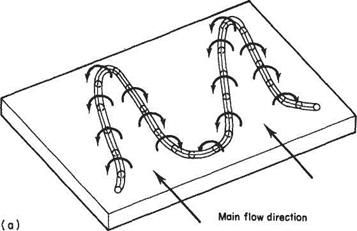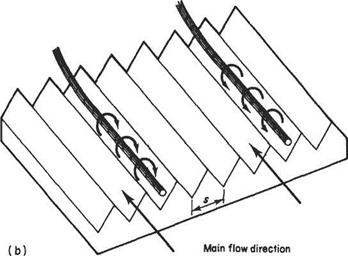Riblets
A moderately effective way of reducing turbulent skin friction involves surface modification in the form of riblets. These may take many forms, but essentially consist of minute streamwise ridges and valleys. One possible configuration is depicted in Fig. 8.36b. Similar triangular-shaped riblets are available in the form of polymeric film from the 3M Company. The optimum, non-dimensional, spanwise spacing between the riblets is given in wall units (see Section 7.10.5) by
j+ = sy/rw/v = 10 to 20
This corresponds to an actual spacing of 25 to 75 jim for flight conditions. (Note that the thickness of a human hair is approximately 70 pm). The 3M riblet film has been flight tested on an in-service Airbus A300-600 and on other aircraft. It is currently being used on regular commercial flights of the Airbus A340-300 aircraft by Cathay Pacific. The reduction in skin-friction drag observed was of the order of 5 to 8%. Skin-friction drag accounts for about 50% of the total drag for the Airbus A340-300 (a rather higher proportion than for many other types of airliner). Probably only about 70% of the surface of the aircraft is available to be covered with riblets leading to about 3% reduction in total drag.* This is fairly modest but represents a worthwhile savings in fuel and increase in payload. Riblets have also been used on Olympic-class rowing shells in the United States and on the hull of the Stars and Stripes, the winner of the 1987 America’s Cup yacht race.
The basic concept behind the riblets had many origins, but it was probably the work at NASA Langley® in the United States that led to the present developments.
|
|
|
Fig. 8.36 The effect of riblets on the near-wall structures in a turbulent boundary layer |
The concept was also discovered independently in Germany through the study of the hydrodynamics of riblet-like formations on shark scales.[73] The non-dimensional riblet spacings found on shark scales lie in the range 8 < < 18, i. e. almost identical
to the range of values given above for optimum drag reduction in the experiments of NASA and others on man-made riblets.
Given that the surface area is increased by a factor of 1.5 to 2.0, the actual reduction in mean surface shear stress achieved with riblets is some 12-16%. How do riblets produce a reduction in skin-friction drag? At first sight it is astonishing that such minute modifications to the surface should have such a large effect. The
phenomenon is also in conflict with the classic view in aerodynamics and hydrodynamics that surface roughness should lead to a drag increase. A plausible explanation for the effect of riblets is that they interfere with the development of the near-wall structures in the turbulent boundary that are mainly responsible for generating the wall shear stress. (See Section 7.10.8) These structures can be thought of as ‘hairpin’ vortices that form near the wall, as depicted in Fig. 8.36a. As these vortices grow and develop in time they reach a point where the head of the vortex is violently ejected away from the wall. Simultaneously the contra-rotating, streamwise- oriented, legs of the vortex move closer together, thereby inducing a powerful down – wash of high-momentum fluid between the vortex legs. This sequence of events is often termed a ‘near-wall burst’. It is thought that riblets act to impede the close approach of the vortex legs, thereby weakening the bursting process.
















